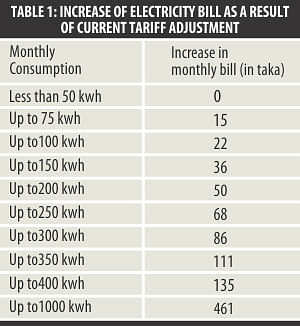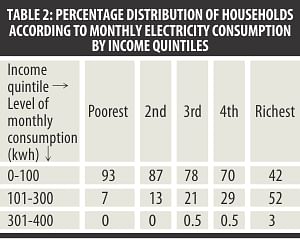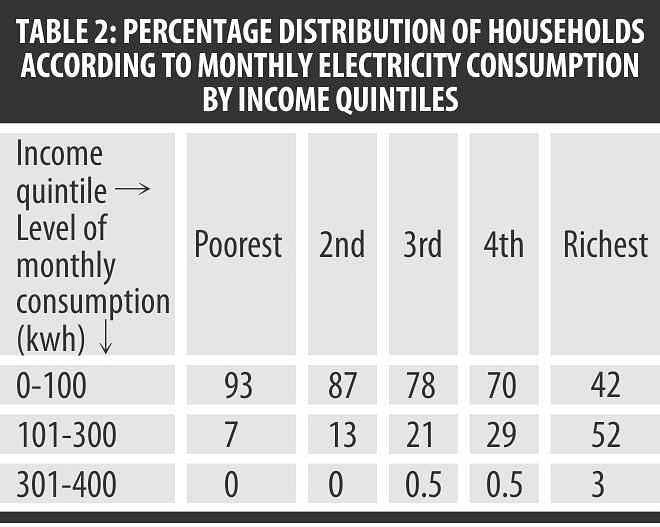Rationalising electricity price hike
Rationalising electricity price hike
Bangladesh Energy Regulatory Commission (BERC) officially announced the electricity tariff adjustments on March 13, increasing them by about 7%. One needs to keep the following information in mind as a background when analysing the effects of the new electricity tariffs;
* Only about 55% of total households have access to electricity. The remaining 45%, who do not have electricity connection, have nothing to do whatsoever with electricity tariff;
* The tariff on electricity used in agricultural sector has not been increased;
* Industry sector did not receive any subsidy in the past, so it did not benefit at all from the spending of public money to subsidise electricity.
Along with domestic consumption, the tariff for industrial use has also been increased in varying rates, which will increase the cost of production and thus increase the cost of living indirectly of all households. However, to know to what extent the cost of living would increase requires rigorous analysis. Yet, it would have been better if tariff on industrial use of electricity had not been increased.

Any increase in price of a commodity can potentially lead to an increase of the total amount of spending on that commodity. However, if consumption of that commodity decreases with increase of its price, total spending on that commodity may even decrease. For example, if the price of a commodity increases by, say 10%, and consequently its demand decreases by more than 10%, total spending on that commodity will decrease. Whether cost of consuming a commodity will increase or decrease following a rise in its price depends on the responsiveness of its demand to its price, in economic terminology, on its price elasticity of demand.
As price of electricity is administratively set, not determined by the market forces, there are some technical problems in estimating its price elasticity. But cross country experience suggests that consumption of electricity usually decreases by a lesser extent than the increase in price, implying an overall increase of cost of electricity. But the question is who, and to what extent, will be affected by such increase?
45% of the total households that do not have access to electricity will not be affected at all by the adjustment of electricity tariffs. Even the remaining 55% percent of the households, which have access to electricity, are not evenly distributed by income quintile. According to the Household Income and Expenditure Survey (HIES) 2010, only 31% of the poorest (quintile) households have access to electricity, while the same rate for the richest (quintile) is about 74%. This means only 31% of the households belonging to poorest 20% of the country are currently benefited by the electricity subsidy. At the same time, 74% households of the richest 20% are benefited from the same subsidy. In plain words, the benefit of the current electricity is highly regressive. This provides a strong ground for adjustment of the current electricity tariff on domestic consumption.
Following the new tariff structure, monthly electricity bill will increase depending on the level of monthly consumption as follows:
Along with access to electricity, level of monthly consumption of electricity also varies across quintiles. About 93% (of those who have access to electricity) of the poorest quintile consumes less than 100 kwh per month, while this share is 42% for the richest quintile (Table 2).

Differential access to electricity and level of consumption jointly would imply that only about 6% of bottom 20% of households consume up to 100 kwh per month. Assuming normal distribution, half of them will probably consume less than 50 kwh per month, and their monthly bill not be affected by the tariff increase. Less than 0.5% of the bottom 20% of households consume between 101 and 300 kwh per month. This means that only about 3.5% of households belonging to poorest 20% will have to pay some additional amount of money to keep their current level of electricity consumption intact. This share will increase with level of income and will be the highest for the richest income quintile, who consume the highest level of electricity.

This is not to deny that increase in electricity tariff would increase cost of living but to stress two notable aspects of such increase. First, the increase will affect the rich compared to the poor. Those who consume less than 50 kwh per month will not be affected at all. Available information suggests that most of the poor will belong to this consumption slab. Second, a portion of the poor and marginal households may have to pay more as a result of the tariff structure; their additional burden will be less than that on the rich people. Should the state avoid tariff adjustment to subsidise the consumption of the rich while depriving about 45% of its total population of access to electricity? The answer should be no, not only on equity but also on moral ground. However, this does not mean that the country should not try to reduce the cost of electricity generation and strive to increase institutional efficiency of the sector.
The writer is Researcher at Bangladesh Institute of Development Studies (BIDS), former economist, World Bank, and former faculty, Willamette University, USA.
E-mail: cccg67@yahoo.com